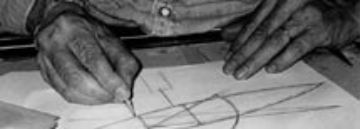

Construction of a sculpture route
JOURNEY'S END
Mataró, 07-1999
Anna Calvera i Teresa-M Sala
Meeting in the sculptor’s studio, with the horrific noise of machinery in the street and the heat typical of Barcelona in summer.
Upon entry, the surprising iron and bronze Squantum Serenissimo sculpture is like a self-portrait of the artist; Pedragosa’s striking presence turned metal idol.
The sculptor is Joan Pedragosa, well-known first as a graphic designer and thereafter as the creator of tabletop or ceiling works that move with the air. He has now decided to embark on a new stage in his life by taking a leap to large formats and putting paper and scissors aside to discover other materials. He is thus constructing three-dimensional pieces as sculptures. All this can be sensed in the studio (which is not a workshop) where white prevails as a background to everything. A long record of research into form lies behind him, which means he is not starting from scratch despite his claims that he is a “new Pedragosa”.
We begin an interactive trialogue.
The sculptor talks about himself, his works and his thoughts.
In the background to his personal development is someone else, Elisabet Albuixech, or “Beta”. She has encouraged him to work, to improve, and to set out on new adventures: «We are what we are, plus what we choose to be», he declares emotively.
The origins of his sculpture work lie in a trip to Patagonia and Tierra de Fuego in January 1997 and the random discovery of stones with forms smoothed by nature. Relics of poetic emotions, objects found and sensually caressed by hand. They were, he states, like sculptures by Henry Moore, who worked with emptiness and fullness on forms similar to these. The forms I make are not random. They are figures designed mathematically, Euclidean generatrices. They are not discoveries but rather forms that have arisen from meditated and calculated research.
The sculptor also shows us a bunch of nails that used to belong to the door of a prison, which tingle if shaken together. They produce an essential melody and become an amulet of sound and touch. The proportion and harmony of the music makes for a perfectly constructed universal language. We try it out by experimenting with these tiny pieces of wrought iron.
Our gazes then rest on a landscape of planes and forms on a large table.
A whole series of geometric figures arranged in space appear in a well-proportioned atmosphere. Artefacts that suggest rotary movements, kineticism with changing axes, fissures and trails that evoke historic innovations.
The structure is based on a very simple concept that was developed to the exact point where material reaches balance, where the emotion of line and aesthetic boldness meet.
From 1997, sculptural language for Pedragosa becomes a context full of opportunities for abstract construction, like a compilation of rational and geometric solutions.
He knows how to grasp interior space, air, with spirals, triangles and facets. On the basis of simplicity of form, these encounter changing structures with highly complex oscillating movements.
From tin to iron and from steel to aluminium, the welded, folded planes focus his research and suggest the variation of models developed in space and in time. Crossed hemispheres with a stylised clean, concise design with movement and different perspectives are often highlighted with incisions and fissures.
These constructions feature both interesting processes of how form unfurls and also highlight different polished, rusty, varnished or shiny finishes.
Attempts. Feeling of recapitulating. Experimenting in order to start all over again.
The relief is nevertheless “deceptive to the eye”. Its heavy, solid appearance is nothing but a simulation. It is a game with a folding language.
Panels that play with the viewer. A playful proposal that offers another kind of landscape. Still lives of the images in Pedragosa’s own universe.
Elsewhere, the “facis, censum, genitum” imago trilogy, under the eye of Squantum Serenissimo, is also striking. Its luster provides finesse and faultlessness, and the hooded Patriarch appears as the last thought. In Mataró, Pere Casanovas’ shop is constructing this effigy that has become a synthesis and beginning, a proposal for a return journey and the start of a fresh voyage upon which medium-format tabletop pieces are now a thing of the past.
End of the trialogue. Visit to the shop. Conversation of four people after the incorporation of Pere Casanovas in an area charged with energy and history where matter takes on special, primary meaning. Here, sculptures become bodies. The future slips into the conversation and towards the end Pedragosa states emphatically that “in the year 2000, everything will look after itself”. A future he looks to with hope.